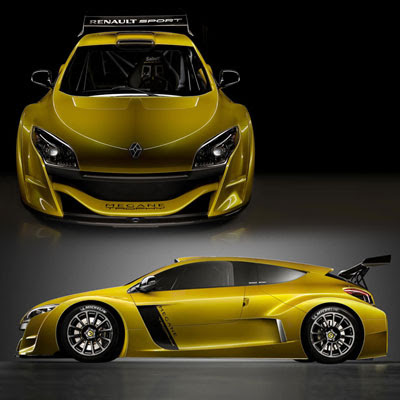|
|
|---|
Tuesday, September 29, 2009

The 2009 Megane Trophy will go on sale at the end of the year in the form of kit after the completion of its development programme which will enable existing cars to be upgraded.
The 2009 Renault Megane Trophy is based on the new Megane Coupe which is powered by the Renault-Nissan Alliance’s mid-rear 3.5-liter V6 24V engine that produces 360 hp.
The front and rear light units and windscreen are from the Megane Coupe road car while flowing lines of the bodywork was designed from digital simulation technology to improve the aerodynamic.
The Renault Megane Trophy features front splitter which channel air flow to the extractors and rear diffuser and wing that generated downforce. Downforce has improved by 20 % with the refinements to the set-up and drag was reduced by 15 % , which together, represent a gain of almost 40% in terms of the new car’s aerodynamic performance over the previous generation vehicle.
The 2009 Renault Megane Trophy is based on the new Megane Coupe which is powered by the Renault-Nissan Alliance’s mid-rear 3.5-liter V6 24V engine that produces 360 hp.
The front and rear light units and windscreen are from the Megane Coupe road car while flowing lines of the bodywork was designed from digital simulation technology to improve the aerodynamic.
The Renault Megane Trophy features front splitter which channel air flow to the extractors and rear diffuser and wing that generated downforce. Downforce has improved by 20 % with the refinements to the set-up and drag was reduced by 15 % , which together, represent a gain of almost 40% in terms of the new car’s aerodynamic performance over the previous generation vehicle.

Apart from that, the Megane Trophy also features butterfly doors reminiscent of the world of GT and sports-prototype racing. The V6 3.5 24V engine is mated to a semi-automatic gearbox with the same mechanical features as the current car, including an FIA-homologated sports-prototype tubular chassis, steering wheel-mounted paddle shift, double wishbone suspension with adjustable dampers, 18-inch wheels and Michelin tires.
The power of the standard 330 hp engine was boosted to 360 hp with the help from the new inlet manifold. Rebuild is still at every 5,500 km for the car’s reliability. According to Renault, with the new aerodynamic gains, the extra power from the engine will enable the 2009 Renault Megane Trophy to lap in similar times to those of a Porsche GT3.
Audi Sport will offer a racing sports car specifically developed for customer use in the form of the powerful 500 hp plus GT3 version of the Audi R8 which will be available from autumn 2009. The logistics and factory space required for the AUDI AG customer programme will be created over the next few months in Ingolstadt, Neckarsulm and Györ.
The Audi R8 conforms to the production-based GT3 regulations allowing the car to be fielded in numerous national and international race series.
Because the GT3 regulations prohibit the use of four-wheel drive the Audi R8 comes with the typical GT rear-wheel drive. The power is transmitted via a newly developed six-speed sequential sports gearbox. The suspension uses almost exclusively components from the production line. A comprehensive list of safety equipment guarantees the highest-level of passive safety. A modified front end and a large rear-wing generate the required downforce for the race track.
The Audi R8, which bears the project name “R16” within Audi Sport, was developed under the direction of Audi Sport. Mid August, the first prototype successfully completed a roll-out in the hands of Audi factory driver Frank Biela.
The Audi R8 conforms to the production-based GT3 regulations allowing the car to be fielded in numerous national and international race series.
Because the GT3 regulations prohibit the use of four-wheel drive the Audi R8 comes with the typical GT rear-wheel drive. The power is transmitted via a newly developed six-speed sequential sports gearbox. The suspension uses almost exclusively components from the production line. A comprehensive list of safety equipment guarantees the highest-level of passive safety. A modified front end and a large rear-wing generate the required downforce for the race track.
The Audi R8, which bears the project name “R16” within Audi Sport, was developed under the direction of Audi Sport. Mid August, the first prototype successfully completed a roll-out in the hands of Audi factory driver Frank Biela.
Ferrari F430 is a sports car manufactured by Ferrari. The F430's brakes were collaboratively designed with Brembo. The F430 features E-Diff, a computer-controlled limited slip differential which enables to vary torque distribution based on inputs such as steering angle and lateral acceleration.
Thursday, September 10, 2009
Introduction
For the most part, consumers previously desiring a vehicle high on fuel efficiency and luxury haven't had much to choose from. Toyota, for example, offers either its super fuel-efficient but bland Prius or not-that-efficient but otherwise premium collection of Lexus luxury hybrid vehicles like the LS 600h L. All of this changes with the 2010 Lexus HS 250h, however. Here, Lexus offers the opportunity to be pampered by your car while still doing your part to help reduce your carbon footprint.
The HS 250h borrows its powertrain from the Camry Hybrid, which is both bigger and more powerful than that used in the Prius. This allows it to post a 0-60-mph time of 8.7 seconds -- fairly quick for a hybrid vehicle. As for fuel economy, the HS 250h has an EPA fuel economy estimate of 35 mpg in combined driving. This is significantly less than the Prius' combined rating of 50 mpg, but it's still the highest of any luxury-branded hybrid vehicle.
Underway, the 2010 Lexus HS 250h easily plays the role of upscale luxury car with a supple ride, a quiet cabin and competent handling. It also has just about every luxury feature one could wish for as either standard or optional, as well as the promise of upscale service treatment at the dealership. As with many luxury vehicles, however, it is all too easy to jack up the HS 250h's price with the various option packages.
If you like the idea of the Lexus HS 250h but find its price a bit too dear, you might also consider the Ford Fusion Hybrid or the Nissan Altima Hybrid, though the latter is sold in just a handful of states. Both offer an affable combination of economy, luxury and athleticism. For now, however, the HS 250h basically exists in a class of one, where premium brand luxury and presence can be had along with fuel economy that's superior to that of a subcompact economy car.
Labels: Automobiles Reviews
Subscribe to:
Posts (Atom)
























